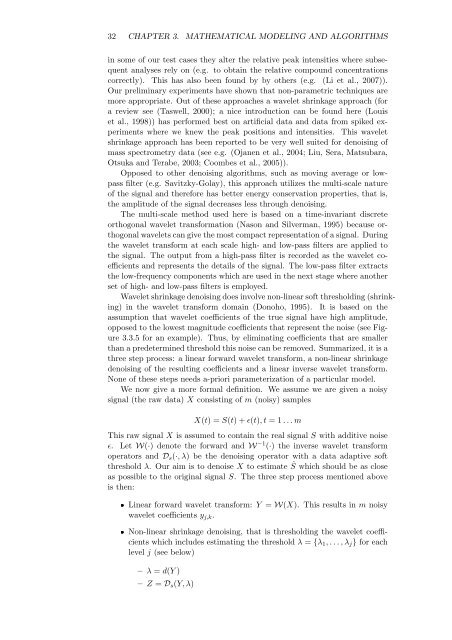New Statistical Algorithms for the Analysis of Mass - FU Berlin, FB MI ...
New Statistical Algorithms for the Analysis of Mass - FU Berlin, FB MI ...
New Statistical Algorithms for the Analysis of Mass - FU Berlin, FB MI ...
You also want an ePaper? Increase the reach of your titles
YUMPU automatically turns print PDFs into web optimized ePapers that Google loves.
32 CHAPTER 3. MATHEMATICAL MODELING AND ALGORITHMS<br />
in some <strong>of</strong> our test cases <strong>the</strong>y alter <strong>the</strong> relative peak intensities where subsequent<br />
analyses rely on (e.g. to obtain <strong>the</strong> relative compound concentrations<br />
correctly). This has also been found by by o<strong>the</strong>rs (e.g. (Li et al., 2007)).<br />
Our preliminary experiments have shown that non-parametric techniques are<br />
more appropriate. Out <strong>of</strong> <strong>the</strong>se approaches a wavelet shrinkage approach (<strong>for</strong><br />
a review see (Taswell, 2000); a nice introduction can be found here (Louis<br />
et al., 1998)) has per<strong>for</strong>med best on artificial data and data from spiked experiments<br />
where we knew <strong>the</strong> peak positions and intensities. This wavelet<br />
shrinkage approach has been reported to be very well suited <strong>for</strong> denoising <strong>of</strong><br />
mass spectrometry data (see e.g. (Ojanen et al., 2004; Liu, Sera, Matsubara,<br />
Otsuka and Terabe, 2003; Coombes et al., 2005)).<br />
Opposed to o<strong>the</strong>r denoising algorithms, such as moving average or lowpass<br />
filter (e.g. Savitzky-Golay), this approach utilizes <strong>the</strong> multi-scale nature<br />
<strong>of</strong> <strong>the</strong> signal and <strong>the</strong>re<strong>for</strong>e has better energy conservation properties, that is,<br />
<strong>the</strong> amplitude <strong>of</strong> <strong>the</strong> signal decreases less through denoising.<br />
The multi-scale method used here is based on a time-invariant discrete<br />
orthogonal wavelet trans<strong>for</strong>mation (Nason and Silverman, 1995) because orthogonal<br />
wavelets can give <strong>the</strong> most compact representation <strong>of</strong> a signal. During<br />
<strong>the</strong> wavelet trans<strong>for</strong>m at each scale high- and low-pass filters are applied to<br />
<strong>the</strong> signal. The output from a high-pass filter is recorded as <strong>the</strong> wavelet coefficients<br />
and represents <strong>the</strong> details <strong>of</strong> <strong>the</strong> signal. The low-pass filter extracts<br />
<strong>the</strong> low-frequency components which are used in <strong>the</strong> next stage where ano<strong>the</strong>r<br />
set <strong>of</strong> high- and low-pass filters is employed.<br />
Wavelet shrinkage denoising does involve non-linear s<strong>of</strong>t thresholding (shrinking)<br />
in <strong>the</strong> wavelet trans<strong>for</strong>m domain (Donoho, 1995). It is based on <strong>the</strong><br />
assumption that wavelet coefficients <strong>of</strong> <strong>the</strong> true signal have high amplitude,<br />
opposed to <strong>the</strong> lowest magnitude coefficients that represent <strong>the</strong> noise (see Figure<br />
3.3.5 <strong>for</strong> an example). Thus, by eliminating coefficients that are smaller<br />
than a predetermined threshold this noise can be removed. Summarized, it is a<br />
three step process: a linear <strong>for</strong>ward wavelet trans<strong>for</strong>m, a non-linear shrinkage<br />
denoising <strong>of</strong> <strong>the</strong> resulting coefficients and a linear inverse wavelet trans<strong>for</strong>m.<br />
None <strong>of</strong> <strong>the</strong>se steps needs a-priori parameterization <strong>of</strong> a particular model.<br />
We now give a more <strong>for</strong>mal definition. We assume we are given a noisy<br />
signal (<strong>the</strong> raw data) X consisting <strong>of</strong> m (noisy) samples<br />
X(t) = S(t) + ɛ(t), t = 1 . . . m<br />
This raw signal X is assumed to contain <strong>the</strong> real signal S with additive noise<br />
ɛ. Let W(·) denote <strong>the</strong> <strong>for</strong>ward and W −1 (·) <strong>the</strong> inverse wavelet trans<strong>for</strong>m<br />
operators and Ds(·, λ) be <strong>the</strong> denoising operator with a data adaptive s<strong>of</strong>t<br />
threshold λ. Our aim is to denoise X to estimate ˆ S which should be as close<br />
as possible to <strong>the</strong> original signal S. The three step process mentioned above<br />
is <strong>the</strong>n:<br />
� Linear <strong>for</strong>ward wavelet trans<strong>for</strong>m: Y = W(X). This results in m noisy<br />
wavelet coefficients yj,k.<br />
� Non-linear shrinkage denoising, that is thresholding <strong>the</strong> wavelet coefficients<br />
which includes estimating <strong>the</strong> threshold λ = {λ1, . . . , λj} <strong>for</strong> each<br />
level j (see below)<br />
– λ = d(Y )<br />
– Z = Ds(Y, λ)









